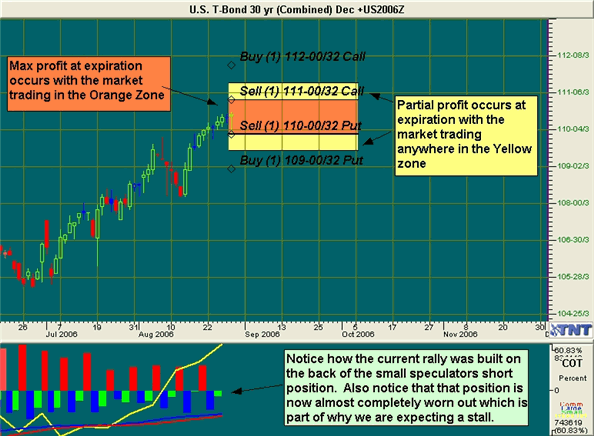- Market: October 2006 30-Year T- Bond (USZ6) *Oct. Options trade based on the December futures price.
- Tick value: 1/64th = $15.625
- Option Expiration: 09/22/06
- Trade Description: Short Condor Credit Spread
- Max Risk: $500
- Max Profit: $500
- Risk Reward ratio 1:1 *This is a normal ratio for any credit spread.
Buy one October 2006 30 Yr. T-Bond 112 call, also buy one October 30 Yr. T-Bond 109 put, while selling one October 30 Yr. T-Bond 111 call, and sell one October 30 Yr. T-Bond 110 call. For a combined credit of of 32/64th ($500) or less to open a position.
Technical / Fundamental Explanation
First of all those of you who are following along should notice that the risk reward ratio on this trade is different from most of our other trades. I want to take a moment and explain why. Most of you know that we strive to put trades on that have a risk reward ratio greater than 3:1. This rule only applies to debit spreads. The above trade is a credit spread. Credit spreads normally have an inverted risk reward ratio. This is because most of the time a credit spread is in some way taking the other side of a "normal" trade. Credit spreads have one major advantage over debit spreads. Credit spread benefit from time decay or Theta. Unlike buying options, where each day that you own them they lose a little value due to the fact that they are a wasting asset. So credit spreads turn one of the biggest problems associated with trading options on it's head and makes it a positive rather than a negative. That again being the fact that time decay works for you rather than against you. In fact the best case scenario for any credit spread is for all the options to expire worthless. Then we get to keep all of the premium that we received when putting this trade on.
So now let me explain why this particular credit spread is the one that we chose. Bonds have been rallying due to the Fed. pausing on its interest rate hiking cycle. On a fundamental level this makes sense. But lets ignore the "funny mental's" for now and turn to technicals. The current rally has been built on the backs of the small speculators short positions, as I pointed out on the chart below. Notice how as the rally has progressed more and more, small traders (represented in the chart below by the green bars on the histogram) have been stopped out all along the way and are now almost flat. These small traders are the "fuel" for the rally that we have seen and it should be clear on the chart below that we are running out of fuel. So this should lead to a consolidation in the near term which is exactly what this trade wants the market to do. This trade in short term on purpose because again we want these options to expire worthless as soon as possible because this is how we make our profit.

Profit Goal
Max profit assuming a credit of 32/64th fill is the credit ($500). Max profit occurs at expiration with the 30 Yr. T-Bond trading between 110 and 111. The trade is profitable at expiration if the 30 Yr. T-Bond is trading any where between 109 1/2 and 111 1/2 (break even points) which means we have a band of two full basis points in the 30 Yr. T-Bond that we can profit in.
Risk Analysis
Max risk assuming a 32 point fill is $500. This occurs at expiration with the 30 Yr. T-Bond trading below 109 or above 112.
Derek Frey is Head Trader at Odom & Frey Futures & Options.
Disclaimer
Past performance is not indicative of future results. Trading futures and options is not suitable for everyone. There is a substantial risk of loss in trading futures and options.